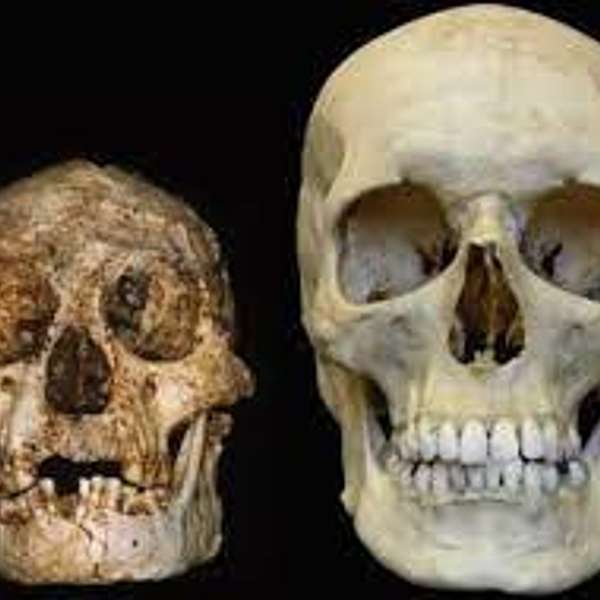
Tennessee Ghosts and Legends
Join me on a journey through Tennessee's mysterious and haunted past! Each season will be comprised of ten episodes you don't want to miss. You'll hear about some of the volunteer state's more famous and lesser known hauntings, and learn the local lore behind the legend. I am your host, Lyle Russell, and this is Tennessee Ghosts and Legends!
Tennessee Ghosts and Legends
Episode 12: The Legend of the Tennessee Pygmies
In this episode, we’ll explore a folk tale that has endured in Tennessee history since the early 1800s, where farmers in White County discovered hundreds of graves under their crop fields. Allow me to introduce you to the archeological mystery of the Tennessee Pygmy tribe.
In the spring of 1820, on the shores of the Caney Fork River five miles south of Sparta, Tennessee, a local farmer and schoolteacher named Turner Lane made a startling discovery. While plowing his fields, he uncovered graves, several of them in fact, but what was in them was even more surprising. Mr. Lane discovered multiple graves full of tiny, intentionally aligned skeletons buried within an earthen coffin of limestone. He reported that the skeletons were small, some with skulls only three inches around with other proportionately small bones. At first, he thought he’d uncovered a mass grave of ancient children buried beneath his farm, for the graves and their contents were very, very old. On further inspection, however, he observed that the skulls were not of a child but of a very small adult measuring between 2.5 and 3 feet tall, and there were hundreds of them. With other similar discoveries on nearby farms, the legend of the Tennessee Pygmies was born.
The small graves measures around ten inches wide and eighteen inches long, each lined with a blue-hued limestone that was not usually found in that area. Accompanying the tiny skeletons in each grave was a black clay vessel containing a well-preserved conch shell. Some others had pipes and cooking utensils within. Each of these items suggests a ritual burial of some importance to those who buried them. Each of the skeletons was also arranged in a particular fashion. Their heads all faced to the east as they lie on their backs. One hand was laid across the breast while the other was placed on the vessel of shells. They were also painstakingly placed in a north to south alignment, with their heads to the south. These conditions Mr. Lane documented on his farm caused him to make the claim that there was once a race of small humans that inhabited this part of the world. He boxed and shipped several specimens to the Tennessee Antiquarian Society in Nashville, though in none of the graves could he find a perfect or complete skeleton. Had Turner Lane made a monumental discovery in human evolution? Did he actually discover a race of small prehistoric humans? While some were convinced he had, others were skeptical.
The artifacts shipped to Nashville were examined by several academic and scientific experts. One of those experts was Dr. John Overton. Dr. Overton observed that the skull Mr. Lane sent had an artificially flattened occipital area and noted that the contents appeared, quote, “to be the cranium of an adult human being of ordinary stature.” However, even with skeptics questioning the find, Mr. Lane’s discovery went as viral as an early 1800s newspaper could take it. Stories of a small race of humans found in Middle Tennessee spread to almost every newspaper in the country and eventually went global. Sparta and White County were marked as an archeological must-visit locale. All the while, additional graves were discovered. Finally, a few years after the first discovery, a federal geologist named George Featherstonhaugh came to White County to meet with Mr. Lane and his sons, Alexander and Jacob, to see what all the fuss was about. He and the Lanes visited several sites where graves were found and even discovered some new ones. After opening a fresh grave himself, Featherstonhaugh came to the conclusion that these were not pygmy graves at all. He claimed these were secondary burials of the bones of normal sized adults. On one farm owned by a Mr. Doyle, Featherstonhaugh told Doyle about this conclusion and that as a scientist, he was bound to be skeptical and offer an alternative possibility of the origin of the graves.
He told the Lane’s and Doyle that it was a common burial practice of Western tribes to display their dead on poles and scaffolds until the flesh and organs were gone, then bundle the bones into a small grave for burial. Mr. Doyle did not take kindly to the insult to his pygmies and their grandeur. Featherstonhaugh wrote that: “Mr. Doyle was not at all pleased to have his wonder taken to pieces in this way and fought for his pygmies with all the pertinacity on an inventor of genera and species for shells. I regretted my indiscretion and was determined henceforth to be as careful about interfering betwixt a man and his pygmies as I would betwixt a man and his wife.” Two other prominent scientists of the day, Gerald Troost and Dr. Samuel Morton, also met with Featherstonhaugh after his experiences in Sparta and both agreed that the skeletons were a mashup of pieces of multiple deceased people within these small graves that were buried second-hand. With their reports on the pygmy grave frenzy being a misidentification of bones, the matter was seemingly put to a final rest. However, eighteen years later, the fervor over the pygmy graves would come roaring back to life.
The idea of races of giants, pygmies and other races referred to as “wee folk” existed long before the discovery of these graves. In 1726, Jonathan Swift published Gulliver’s Travels, which portrayed a race of tiny humans called the Lilliputians and a race of giant humans known as the Brobdingnagians against a normal-sized human named Lemuel Gulliver. Another potential source that sparked the myth of pygmies may come from European folklore. Early American settlers from Europe came with stories of elves, dwarves, leprechauns, and fairies. Even Native Americans held folklore beliefs over the existence of little people and even had names for them, such as the Laurel People, the Rock People, and the Dogwood People. A Cayuga chief called Deskaheh spoke of a race of little people having withdrawn westward with the coming of the white man and are rarely seen anymore. Could those legends be tied to the existence of pygmies?
The question of the pygmies and the validity of their existence never truly went away, even when the graves were widely accepted as incorrectly identified. New grave sites of the same arrangements Mr. Lane found on his farm in White County were discovered every so often in other places, such as the shores of Stones River in Davidson County, Obed’s River in Overton County, then in Wilson County, and in Coffee County. Academics would continue to argue the merits and detractions of these finds up to the outbreak of the Civil War. After the war ended, a Union General named Robert Milroy launched a silver, lead, and oil mining company in Middle Tennessee. As they surveyed for mining operations, he would discover hundreds more of these tiny graves, completely undisturbed, throughout the Cumberland River basin in Davidson County. In 1865, the newspapers again would print stories about discoveries of a race of pygmy people that inhabited Tennessee thousands of years ago. The Nashville Dispatch referred to these bone finds as “an extinct race of human dwarves, the lilliputian aborigines of Tennessee.” Again, the skeptics hastily reminded the nation that these new discoveries were of the same origin as the old graves, full of bundled bones of normal-sized adults, but the cat was out of the bag and pygmy fever had returned to Tennessee.
Despite the efforts of several experts, the myth of the Tennessee Pygmies endured. One of the most scathing rebukes of the existence of the pygmy race came from the Smithsonian Institute. In 1874, the Smithsonian began an inquiry into the pygmy stories to dispel the myth once and for all. After two years of exhaustive examination of multiple skeletal fragments from several of the known pygmy gravesites, Joseph Henry, the first secretary of the Smithsonian, published a report in January of 1876 titled, “The Tennessee Pygmies.” The report said:
“The Smithsonian institution has recently taken means to ascertain what foundation there might be for the reports of the former existence of a race of pygmies in different parts of the country. Within the last ten years it was reported that at least three hundred bodies have been ploughed up in the county. The fragments thus sent proved on examination in no way abnormal, and corresponded with, and were evidently the remains of two young children between three and four years old. There can, however, be no doubt that the belief in the existence of the pygmies has grown out of the consideration of the size of the graves rather than of their contents.”
The anthropological community was finally satisfied the Tennessee Pygmies were an archeological myth, but members of the public were not fazed by the findings at all and kept the legend alive.
Newspapers wanted stories that sold newspapers, and pygmies were selling like wildfire. In March of 1876, the New York Times ran a lengthy piece about the Pygmies of Tennessee as the answer to the discovery of the Kentucky Giants, a grouping of supposed giant skeletons over eight feet discovered in Columbia, Kentucky that same year. The giants were associated with the myths surrounding the ancient mound-building humans from the Ohio River Valley through the south down into the Mississippi Valley. It wasn’t long before the pygmy myths became associated with the mound builders as well, much like a Tennessee pygmy David to a Kentucky giant Goliath. Also in March of that year, a large discovery of pygmy graves in Woodbury and Hillsboro, located in Coffee County, Tennessee was reported and compared in size and scope to the 1820s find on Mr. Lane’s farm in White County. The discovery in Hillsboro was spread over six acres, filled with up to 100,000 graves of diminutive humans about three feet tall. This new mass grave would once again give the public the perception that the pygmies were real and perhaps the Smithsonian reports were less than honest.
A third round of pygmy fever came back in a different guise in the late 1890s. This time, the pygmies would be revived in literature and art and giving them a much wider audience. An early female novelist from Tennessee, Mary Murfree, wrote an entire novel based on the culture of the pygmy race in her book, In the Stranger People’s Country. In it, she recounts generations of contact between a Appalachian mountain community and “the little people’s” race. Stories like hers and Margaret Peake’s book titled Born of Flame, revived the pygmy myth in the imaginations of readers. Artists and writers who spent time in Appalachia wrote stories and mused on the existence of these tiny prehistoric Americans and established a near romanticism around their plight. Along with these flights of fancy came tourism and people who wanted to discover the mystery for themselves, which persisted on and off up through the 1980s. They were resurrected again in the imaginations of literature with rewrites on early American history by epigrapher Barry Fell. Peer reviews were not kind to him, and many of those stories fell flat. However, believers in the existence of pygmies would hold on. Then, in 2003, those believers were rewarded with scientific evidence that may prove the existence of the cousins of the Tennessee Pygmies.
On the island of Flores in Indonesia, a new species of early human was discovered. Homo floresiensis, nicknamed Hobbit, stood just over three feet tall with short legs and child-sized bones, similar in size to the bones found in White County, Tennessee. Even with these similarities, Homo floresiensis has only been found on the island of Flores and is thought to have occurred because of the remote isolation of their island nation. Also found on Flores was a similar pygmy elephant species that went extinct around the same time, and also thought to be small in size due to island isolation and a lack of predators. There are some scientific theories that contradict this hypothesis, stating that the ancestors of Homo floresiensis may have arrived at the island already small in stature and the gene continued. Though they do not have any direct connection to the pygmy graves in Tennessee, their discovery proves that a prehistoric pygmy race of humans did exist on earth, and that all evidence of their existence and origins may simply be lying in wait to be discovered. If found, proof of the Tennessee pygmy could turn the science community on end and reignite the pygmy fever that started in Sparta back in 1820.
Until then, where could these mythical pygmies have come from? On a recent visit to Old Stone Fort State Archeological Park in Manchester, Tennessee, I learned that the prehistoric mound builders in the eastern United States aligned their trade and hunting routes to where Middle Tennessee was their crossroads. Once prehistoric peoples ventured away from their ancestral homes and hunting grounds, contact with other peoples and tribes established a thriving trade road that crossed through the areas that the pygmy graves were found. Mound builders from the lower Ohio River Valley, coastal tribes in the Carolinas and Georgia, hill tribes from the Ozarks in Missouri and peoples from the Mississippi Valley all ventured inward toward Tennessee to where the Duck and Little Duck rivers created a 50-acre natural island prairie paradise. The prehistoric walls around Old Stone Fort were erected to protect the island, but little is known about the peoples who inhabited it, what they did there, or why they chose that particular spot. The artifacts discovered there and along the routes to other known mound-builder communities suggest there were goods and agriculture from multiple biomes of the southeast. These early peoples interacted with each other when they came out of their isolation. Were there pygmies among them?
The early mound builders are thought to be descended from the Toltecs and Aztecs, who were not known to be overly hospitable to outsiders. Did those early migrating tribes take over the pygmy dominance of the area and drive them out? Were the earthen walls erected to protect them from pygmy attacks? Or were the pygmies a trading tribe who eventually integrated with the other tribes that ventured into the area? Were they a counter race to the giants found in Kentucky? Was there a race of small people who inhabited Tennessee before the coming of the Cherokee? In any case, Middle Tennessee was a crossroads of trade and commerce for prehistoric people in America, and if there was a pygmy tribe thriving in Tennessee, it would make sense that they were here, and that evidence of their existence would remain. What do you think? Did these prehistoric pygmies exist along the Cumberland Plateau, or are these discovered remains from the ritualistic burial practice of normal-sized adults? Until definitive proof is found, the existence of pygmies will remain an enduring legend of Tennessee.
Podcasts we love
Check out these other fine podcasts recommended by us, not an algorithm.

Southern Gothic
Southern Gothic Media